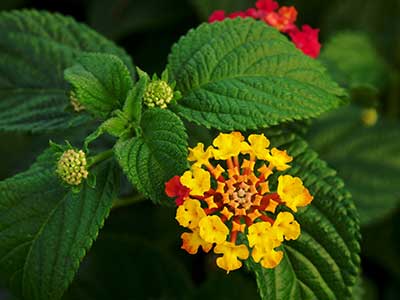Relevance: GS-3: Conservation, environmental pollution and degradation, environmental impact assessment; Infrastructure: Energy
Key Phrases: Lantana Camara, Invasive species, Gasification, Biochar, Producer gas, clean energy transition.
Why in News?
- There is increasing consensus in the scientific community that we have to get rid of lantana camara quickly, in an ecologically-sensitive manner and by working closely with the communities who depend on forest resources for their livelihoods.
Key Points:
- The lantana camara is a dangerous weed that has taken over 40% of India’s forests, displacing the native flora and increasing human-wildlife conflict.
- Considering the scale of infestation and the cost of eradicating lantana
from over 13 million hectares of forestland, is no small feat.
- Currently, it is estimated to cost from ₹80,000 to ₹1,20,000 to clear a hectare of densely-infested land, with repeated interventions over three years.
-
“Alien invasive” is a term used to describe plants that are moved out of their natural habitats and end up exploiting the local biota in their new environment.
-
There has been an unchecked increase in the density of Lantana camara, an alien invasive woody shrub, in the Western Ghats. The growth is worrisome as the Western Ghats are a biodiversity hot spot.
-
Introduced in India in 1807, Lantana camara is originally from South and Central America and has the dubious distinction of being one of the world’s most invasive species.
-
L. camara can outcompete native species, leading to a reduction in biodiversity. It can also cause problems if it invades agricultural areas as a result of its toxicity to livestock, as well as its ability to form dense thickets which, if left unchecked, can greatly reduce the productivity of farmland.
Finding a Solution:
There is now increasing interest in linking restoration programmes with uses of the weed to offset part of the costs.
- Gasification is the latest lantana-focused initiative launched by
the Centre for Social and Environmental Innovation (CSEI) at the
Ashoka Trust for Research in Ecology and the Environment (ATREE), a
research institute based in Bengaluru.
- This process involves burning wood chips at high temperatures in a low-oxygen environment, to yield a clean and combustible fuel called producer gas and a by-product called biochar, a carbon-rich, charcoal-like substance that can improve soil fertility and sequester carbon.
-
Producer gas is a mixture of flammable gases (principally carbon monoxide and hydrogen) and nonflammable gases (mainly nitrogen and carbon dioxide) made by the partial combustion of carbonaceous substances, usually coal, in an atmosphere of air and steam.
- Through the Lantana Crafts Centre set up in 2003, ATREE has been working
towards removing the plant, restoring native forest species and generating
livelihoods for the Soliga tribal community in southern Karnataka.
- Their ability to forage non-timber forest produce (NTFPs) had been drastically impacted by the weed.
- Though effective, there are challenges with scaling up this artisanal business model.
- Mining and repurposing lantana is expensive; and handicrafts and furniture are made from lantana stems, which account for only 20 per cent of the plant.
- In contrast, Gasification would make use of the entire plant.
The lantana gasification trial
CSEI-ATREE teamed up with BioTherm to explore the possibility of using lantana as the fuel in a gasifier.
- The sun-dried lantana wood chips were placed in a gasifier of 50 kg per hour capacity for eight hours.
- This process generated 1.2 million Kcal (kilocalories) of energy, and produced a blue flame indicating that the gas produced was clean and devoid of any particulate matter or tar.
- The eight-hour trial also produced 30 kg of biochar from the 400 kg of lantana gasified.
Benefits:
- The benefits in the context of the Nilgiris and other parts of the
Western Ghats were examined where the lantana menace is rampant.
- Tea factories, coffee curing units, hotels and resorts all currently use LPG and wood for heating and drying purposes.
- This can potentially be replaced by producer gas that results from gasifying lantana.
- The soil in such a hilly region is acidic which, when compounded by
nutrient run-off caused by heavy rain, affects agriculture here.
- Biochar could be a silver bullet in terms of significantly improving the quality of the soil as the porous substance preserves water and essential plant nutrients, and reduces the use of harmful chemical fertilisers.
- Some organic tea gardens in Assam have adopted the practice of applying biochar.
- A plantation in Sri Lanka even experienced increased productivity during drought years.
- On a large scale, biochar can trap tonnes of carbon in the soil, preventing it from being released into the atmosphere to contribute to global warming.
- The IPCC’s 2018 report says, ‘converting waste plant material into a charcoal-like substance called biochar and burying it in soil can also be used to store carbon away from the atmosphere for decades to centuries’.
- This carbon-negative process is significant in light of India’s pledge
at COP26 last year to reach net zero emissions by 2070 and to meet 50 per
cent of its electricity requirements from renewable energy sources by 2030.
- Coal, oil and natural gas account for 75 per cent of energy use now and alternatives like wood gasification could play a key role in this clean energy transition.
- Moreover, at the very root of this process, it adds incentive for the large-scale removal of lantana, offering employment opportunities and restoring native forest ecosystems.
Conclusion:
- Observing the promising results of early trials, it is critical to conduct further tests and explore the feasibility of the gasification option on a larger scale.
Source: The Hindu BL
Mains Question:
Q.Monitoring the eradication mechanism of the invasive alien species and restoration of natural plants is important to mitigate human-wildlife conflicts. Discuss.









